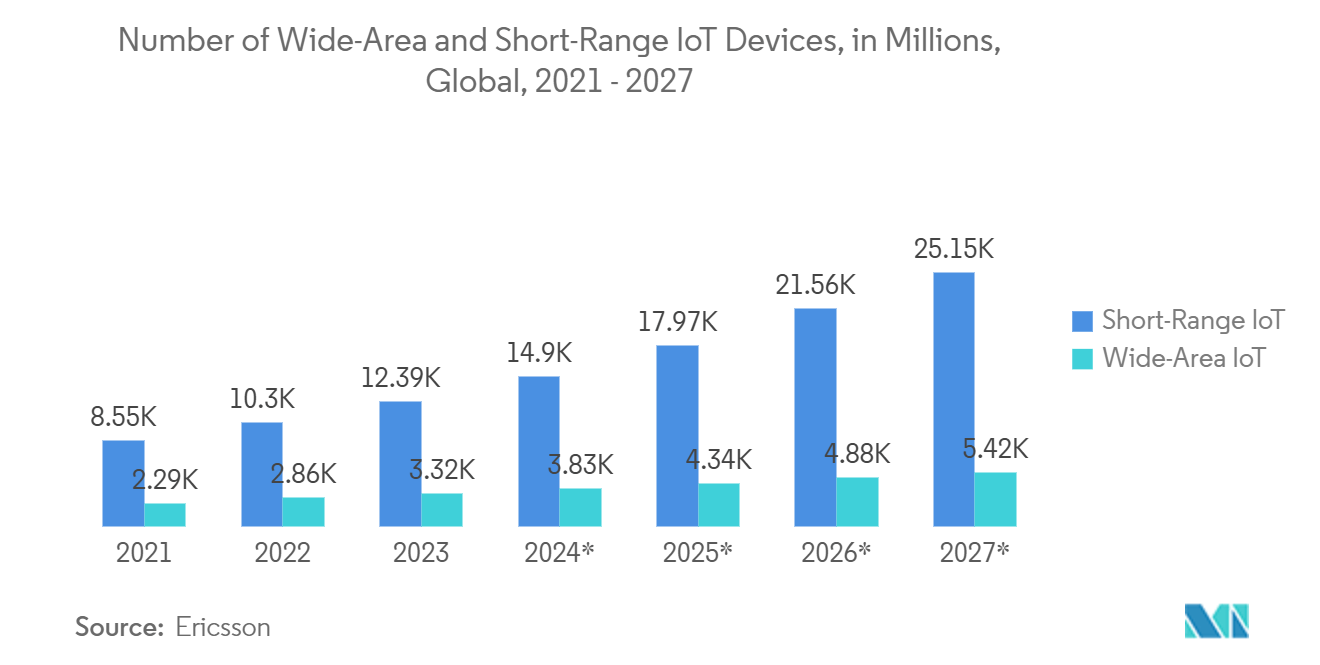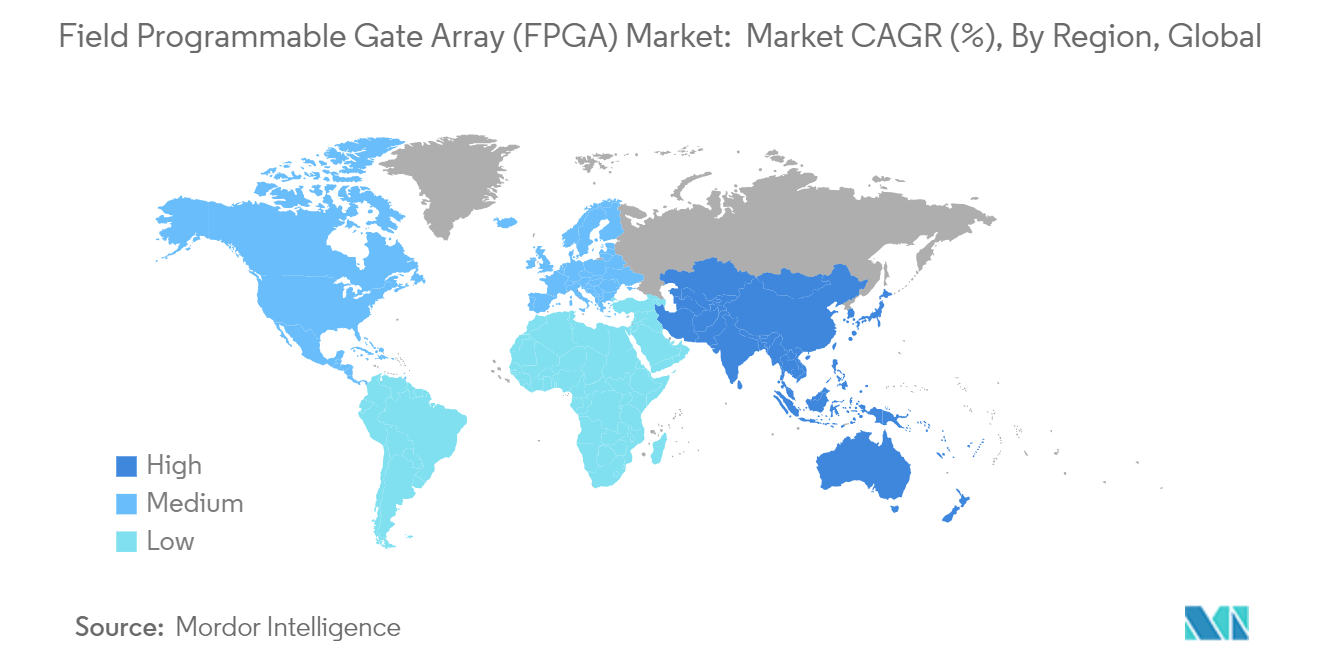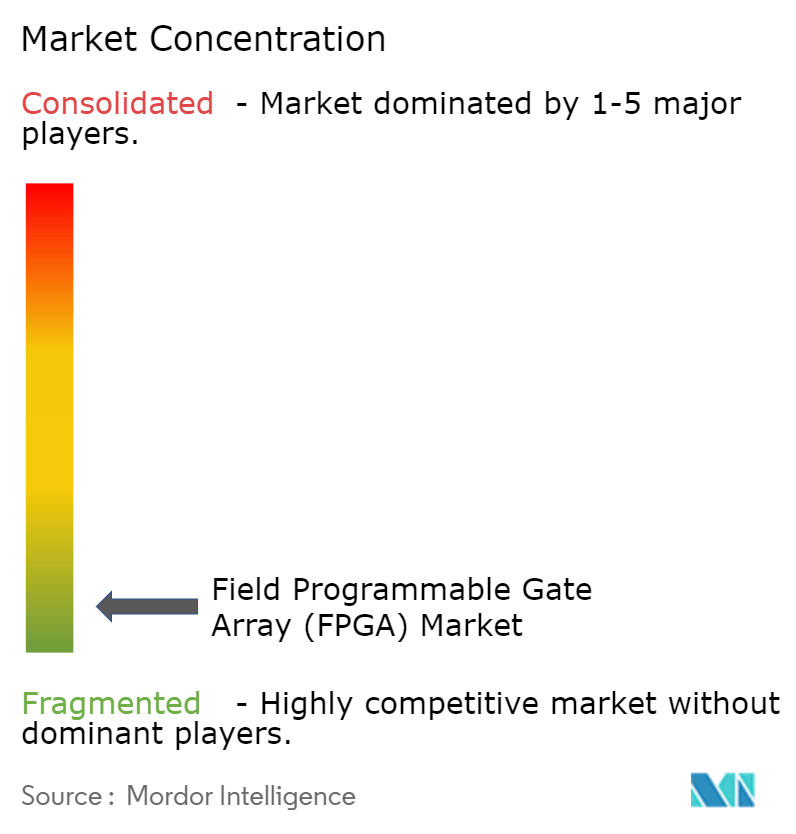
| Study Period | 2019 - 2030 |
| Market Size (2025) | USD 11.14 Billion |
| Market Size (2030) | USD 18.76 Billion |
| CAGR (2025 - 2030) | 10.98 % |
| Fastest Growing Market | Asia Pacific |
| Largest Market | Asia Pacific |
| Market Concentration | Low |
Major Players-Market-logo.webp)
*Disclaimer: Major Players sorted in no particular order |
Field Programmable Gate Array (FPGA) Market Analysis
The Field Programmable Gate Array Market size is estimated at USD 11.14 billion in 2025, and is expected to reach USD 18.76 billion by 2030, at a CAGR of 10.98% during the forecast period (2025-2030).
Field-programmable gate arrays (FPGAs) are integrated circuits featuring a programmable hardware fabric. In contrast to ASICs and graphics processing units (GPUs), the circuitry within an FPGA chip is not permanently etched; it can be reprogrammed as needed. This flexibility positions FPGAs as a viable alternative to ASICs, which demand extensive development time and substantial investment in design and fabrication.
- Consequently, FPGAs accelerate execution in real-time scenarios such as object motion tracking, video streaming, and speech recognition. The growing demand for high-performance computing and the increasing complexity of neural networks further underscore the importance of FPGAs in modern technology. As industries continue to evolve, the role of FPGAs in facilitating advanced computational tasks becomes increasingly critical, making them indispensable in various high-stakes applications.
- FPGAs are becoming increasingly vital in data centers and adaptable cloud computing systems due to their energy-efficient and customizable acceleration capabilities. Major players such as Intel, Microsoft, Amazon, Baidu, IBM, and Huawei are integrating FPGAs into their cloud and data center services, making them readily available to application developers. This integration empowers developers to harness the high performance and low power consumption of FPGAs, boosting the efficiency and scalability of their applications. In addition to commercial applications, many academic and research initiatives worldwide utilize FPGAs for remote acceleration and user flexibility. These initiatives seek to explore novel applications and enhance existing ones, leveraging the distinct advantages of FPGAs to foster innovation and technological progress across diverse domains.
- For instance, in October 2024, AMD unveiled its latest addition to the record-breaking family of accelerators, the AMD Alveo UL3422, specifically designed for ultra-low latency electronic trading applications. The Alveo UL3422 offers trading firms, market makers, and financial institutions a compact accelerator optimized for rack space and cost, ensuring a swift deployment across various servers. Packaged in a slim FHHL (full height, half length) form factor, the Alveo UL3422 seamlessly integrates into diverse servers and co-location exchange data centers. While the Alveo UL3422 reduces port density, onboard memory, and connectivity options compared to its predecessor, it retains the same AMD Virtex UltraScale+ VU2P FPGA, ensuring ultra-low latency performance.
- FPGAs are enhancing various automotive subsystems, such as in-vehicle infotainment, advanced driver assistance systems (ADAS), and charging systems in hybrid and electric vehicles. Thanks to technological advancements, FPGA performance speeds are on the rise, and their prices are becoming more accessible. Their adoption in automotive applications is also witnessing a notable surge. For instance, Intel is broadening the chip's automotive applications, integrating it into HUD displays, head unit hardware, safety features, and beyond. Despite certain cost and performance constraints, FPGAs are increasingly aligning with the demand for next-generation, software-defined vehicles many drivers seek.
- FPGAs offer compelling advantages, but they also come with inherent drawbacks, such as lower performance and higher power consumption. For example, FPGAs, due to their programmable architecture, generally consume more power than ASICs. This increased power consumption stems from the configurable logic blocks, interconnects, and other resources that provide FPGAs with their flexibility. Such power demands can be a significant drawback in applications prioritizing energy efficiency. Furthermore, the very programmability of FPGAs introduces overheads in area, power consumption, and performance, rendering them less ideal for applications demanding peak efficiency and speed.
- The ongoing conflict between Israel and Hamas, amid geopolitical complexities, threatens to disrupt the global semiconductor industry. Israel plays a significant role in Integrated Circuit (IC) production and innovation, which can impact the price and availability of semiconductor devices worldwide used in FPGAs.
- Additionally, in June 2024, Intel Corporation plans to stop building a new chip manufacturing plant worth USD 25 billion in Israel. This could indirectly lower the availability and production volume of solutions based on FPGA applications and impact the global market during the forecast period.
Field Programmable Gate Array (FPGA) Market Trends
IT and Telecommunication Holds Significant Market Share
- IT and telecommunication companies leverage FPGAs for high-performance computing applications, such as artificial intelligence (AI) and machine learning (ML). FPGAs support customized algorithms for tasks like image recognition, natural language processing, and big data analytics, often more efficiently than traditional CPUs and GPUs.
- 5G networks are rapidly expanding, necessitating high-speed and low-latency data processing for optimal performance. FPGAs are ideally positioned to fulfill these demands, especially in 5G base stations and edge computing. They accelerate data processing and adeptly manage the surge in traffic. With the continuous evolution of 5G infrastructure, the appetite for FPGAs in core and edge applications is on the rise.
- According to projections by GSMA, by 2030, China will boast over 1.6 billion 5G connections, representing nearly a third of the global tally. In addition, VIAVI Solutions highlights that by April 2023, the U.S. led globally with 5G network access spanning 503 cities, outpacing China's 356 cities. These developments are poised to unlock significant market opportunities.
- As data traffic surges and the number of connected devices, particularly in IoT and telecommunications, continues to grow, the importance of network security and swift data processing has never been more pronounced. FPGAs, with their capability for hardware-accelerated encryption and secure data processing, adapt swiftly to evolving security demands. This adaptability makes them indispensable for network operators safeguarding vast data while navigating intricate processing challenges.
- The expanding realm of IoT, especially within telecommunications, underscores the demand for versatile, energy-efficient computing solutions adept at managing diverse data streams from myriad devices. FPGAs are carving a niche in IoT gateways and edge computing, enabling local data processing that curtails latency and conserves bandwidth.

Asia Pacific to Register Major Growth
- China's field programmable gate array market has transitioned from heavy reliance on international suppliers to cultivating a robust domestic ecosystem, all in a bid to curtail import dependency. Geopolitical factors, notably trade tensions and export controls, have accentuated the urgency for technological self-reliance. Consequently, domestic players like GOWIN Semiconductor, Shenzhen Pango Microsystems Co., Ltd, and Shanghai Anlogic Infotech Co., Ltd, among others, have risen to prominence, channeling their efforts into innovations to rival established global entities. Furthermore, the market has witnessed a surge in R&D investments, aiming to craft sophisticated FPGAs tailored for high-end applications.
- The advent of 5G technology has emerged as a pivotal catalyst for FPGA adoption in China. With their prowess in efficient data processing and signal transmission, FPGAs have become indispensable in base stations and broader network infrastructures. The count of base stations skyrocketed from 0.15 million in 2019 to 3.38 million in 2023. Data from China's Ministry of Industry and Information Technology reveals that by the close of August 2024, the nation had eclipsed 4.04 million 5G base stations, accounting for 32.1% of the country's total mobile base stations. Additionally, the ministry highlighted that China's 5G mobile subscriber count reached an impressive 966 million.
- Japan, renowned for its leadership in robotics, automotive, electronics, and high-precision manufacturing, has harnessed FPGA technology to bolster its competitive edge. Local manufacturers, including Renesas Electronics Corporation, NEC Corporation, and Socionext Inc., have increasingly contributed to the country's field programmable gate array market, which plays a pivotal role in Japan's advanced technology ecosystem.
- Amid the escalating technological rivalry between the United States and China, Japan is strategically bolstering its semiconductor industry. The nation is channeling 0.71% of its gross domestic product (GDP), equating to USD 25.7 billion, into the semiconductor sector from 2022 to 2025. This investment commitment stands out, being notably more substantial than the state subsidies provided by other industrial nations to their semiconductor sectors.
- The field programmable gate array market in India has transitioned from limited academic and niche industrial applications to widespread adoption in sectors like telecommunications, automotive, and aerospace. With a USD 250 billion IT industry, India is not only a significant player in the global AI ecosystem but also caters to many of the world's banks, manufacturers, and firms.

Field Programmable Gate Array (FPGA) Industry Overview
The degree of competition depends on various factors affecting the market studied, such as brand identity, powerful competitive strategy, and degree of transparency. The market studied has prominent vendors, including Xilinx Inc. (AMD Corporation), Lattice Semiconductor Corporation, Intel Corporation, and Microchip Technology Incorporated, which makes it highly consolidated and competitive. With growing consolidation, technological advancement, and geopolitical scenarios, the market studied is witnessing changes.
In a market where sustainable competitive advantage through innovation is considerably high, the competition will only increase, considering the anticipated surge in demand from new customers from the end-user industries, such as IoT, in which edge computing in connected devices has been witnessing increasing demand.
Field Programmable Gate Array (FPGA) Market Leaders
-
Advanced Micro Devices, Inc.
-
Lattice Semiconductor Corporation
-
QuickLogic Corporation
-
Intel Corporation
-
Achronix Semiconductor Corporation
- *Disclaimer: Major Players sorted in no particular order

Field Programmable Gate Array (FPGA) Market News
- June 2024: Orthogone Technologies, an engineering firm specializing in electronic product development and FPGA design services, joined the Lattice Partner Network from Lattice Semiconductor, the low-power programmable leader. With an aim to help innovators get the most out of their FPGA-based designs, the Lattice Partner Network is a leading FPGA technology ecosystem network of design partners with proven programmable logic design competencies.
- May 2024: AMD has introduced the Spartan UltraScale+ FPGA family, expanding its extensive range of cost-optimized FPGAs and adaptive SoCs. These devices are engineered for I/O-intensive edge applications, offering the highest I/O to logic cell ratio in the industry for FPGAs built on 28nm and smaller process technologies. They also deliver up to 30% lower total power consumption compared to the previous generation and feature the most comprehensive set of security measures in AMD's cost-optimized portfolio.
- March 2024: Advanced Micro Devices, Inc. unveiled its Spartan-7 Field-Programmable Gate Arrays (FPGAs). The launch responds to the demand for customizable, high-performance, and flexible computing hardware. Leveraging advanced 7nm process technology, the Spartan-7 FPGAs promise optimal performance, power efficiency, and scalability, catering to today's computing demands. Furthermore, AMD highlighted that its Spartan 'UltraScale+ devices boast the industry's leading I/O to logic cell ratio for FPGAs, utilizing 28nm and smaller process technologies, featuring up to 572 I/Os and supporting voltages of up to 3.3V.
Field Programmable Gate Array (FPGA) Industry Segmentation
FPGAs are prefabricated silicon instruments that can be electrically programmed in the field to become almost any type of digital circuit or system. They are an array of configurable logic blocks (CLBs) linked together by programmable interconnects. After manufacturing, they can be reprogrammed to meet the needs of the desired application or functionality.
The field programmable gate array (FPGA) market is segmented by configuration (high-end FPGA, mid-range FPGA/low-end FPGA), by architecture (SRAM-based FPGA, anti-fuse based FPGA, flash-based FPGA), by end-user industry (IT and telecommunication, consumer electronics, automotive, industrial, military and aerospace, other end-user industries), by geography (North America [United States, Canada], Europe [Germany, United Kingdom, France, rest of Europe], Asia Pacific [China, Japan, India, South Korea, rest of the Asia Pacific], Latin America [Brazil, Argentina, Mexico, rest of Latin America], Middle East and Africa [United Arab Emirates, Saudi Arabia, South Africa, rest of Middle East and Africa]). The market sizes and forecasts are provided in terms of value in USD for all the above segments.
| By Configuration | High-end FPGA | ||
| Mid-range FPGA/Low-end FPGA | |||
| By Architecture | SRAM-based FPGA | ||
| Anti-fuse based FPGA | |||
| Flash-based FPGA | |||
| By End-user Industry | IT and Telecommunication | ||
| Consumer Electronics | |||
| Automotive | |||
| Industrial | |||
| Military and Aerospace | |||
| Other End-user Industries | |||
| By Geography*** | North America | United States | |
| Canada | |||
| Europe | Germany | ||
| United Kingdom | |||
| France | |||
| Asia | China | ||
| Japan | |||
| India | |||
| South Korea | |||
| Australia and New Zealand | |||
| Latin America | Brazil | ||
| Argentina | |||
| Mexico | |||
| Middle East and Africa | United Arab Emirates | ||
| Saudi Arabia | |||
| South Africa | |||
Field Programmable Gate Array (FPGA) Market Research Faqs
How big is the Field Programmable Gate Array Market?
The Field Programmable Gate Array Market size is expected to reach USD 11.14 billion in 2025 and grow at a CAGR of 10.98% to reach USD 18.76 billion by 2030.
What is the current Field Programmable Gate Array Market size?
In 2025, the Field Programmable Gate Array Market size is expected to reach USD 11.14 billion.
Who are the key players in Field Programmable Gate Array Market?
Advanced Micro Devices, Inc., Lattice Semiconductor Corporation, QuickLogic Corporation, Intel Corporation and Achronix Semiconductor Corporation are the major companies operating in the Field Programmable Gate Array Market.
Which is the fastest growing region in Field Programmable Gate Array Market?
Asia Pacific is estimated to grow at the highest CAGR over the forecast period (2025-2030).
Which region has the biggest share in Field Programmable Gate Array Market?
In 2025, the Asia Pacific accounts for the largest market share in Field Programmable Gate Array Market.
What years does this Field Programmable Gate Array Market cover, and what was the market size in 2024?
In 2024, the Field Programmable Gate Array Market size was estimated at USD 9.92 billion. The report covers the Field Programmable Gate Array Market historical market size for years: 2019, 2020, 2021, 2022, 2023 and 2024. The report also forecasts the Field Programmable Gate Array Market size for years: 2025, 2026, 2027, 2028, 2029 and 2030.
Our Best Selling Reports
Field Programmable Gate Array (FPGA) Industry Report
Statistics for the 2025 Field Programmable Gate Array (FPGA) market share, size and revenue growth rate, created by Mordor Intelligence™ Industry Reports. Field Programmable Gate Array (FPGA) analysis includes a market forecast outlook for 2025 to 2030 and historical overview. Get a sample of this industry analysis as a free report PDF download.




